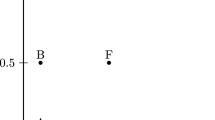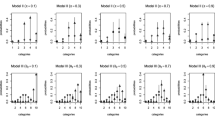Abstract
The paper is the rejoinder to a series of Discussions on the class of cub models for rating data. The main topics advanced by Discussants are reviewed and debated, with focus on the most prominent issues. As a result, the trailhead of possible future research developments is outlined.




Similar content being viewed by others
References
Agresti A (2010) Analysis of ordinal categorical data, 2nd edn. Wiley, Hoboken
Angelini V, Cavapozzi D, Corazzini L, Paccagnella O (2014) Do Danes and Italians rate life satisfaction in the same way? Using vignettes to correct for individual-specific scale biases. Oxf Bull Econ Stat 76(5):643–666
Arboretti R, Bordignon P (2016) Consumer preferences in food packaging: CUB models and conjoint analysis. Br Food J 118(3):527–540
Bandt C (2005) Ordinal time series analysis. Ecol Model 182:229–238
Bandt C, Shiha F (2007) Order patterns in time series. J Time Ser Anal 28:646–65
Bartolucci F, Bacci S, Gnaldi M (2015) Statistical analysis of questionnaires: a unified approach based on R and Stata. Chapman & Hall/CRC, Boca Raton
Benzécri J (1973) L’Analyse des Donnés. L’Analyse des Correspondances. Dunod publisher, Tome II
Biernacki C, Jacques J (2016) Model-based clustering of multivariate ordinal data relying on a stochastic binary search algorithm. Stat Comput 26(5):929–943
Birnbaum A (1968) Some latent traits models and their use in inferring an examinee’s ability. In: Lord FM, Novick MR (eds) Statistical theories of mental test scores. Addison-Wesley, Reading, pp 395–479
Capecchi S, Michelini M (2018) Aprototype for the analysis of time use in Italy. In: Abbruzzo A, Brentari E, Chiodi M, Piacentino D (eds) Book of short papers SIS 2018. Pearson Publisher, London, pp 487–492. ISBN-9788891910233
Capecchi S, Simone R (2019) A proposal for a model-based composite indicators: experience on perceived discrimination in Europe. Soci Ind Res 141(1):95–110
Capecchi S, Endrizzi I, Gasperi F, Piccolo D (2016) A multi-product approach for detecting subjects’ and objects’ covariates in consumer preferences. Br Food J 118(3):515–526
Capecchi S, Meleddu M, Pulina M, Solinas G (2019) Mixture models for consumers’ preferences in healthcare, CRENoS Working Papers 1, Centro Ricerche Economiche Nord Sud, Cagliari-Sassari, Arkadia Editore, Cagliari, ISBN 9788884678355
Corduas M (2008a) Clustering cub models by Kullback–Liebler divergence. In: Proceedings of SCF-CLAFAG Meeting, ESI, Napoli, pp 245–248
Corduas M (2008b) A statistical procedure for clustering ordinal data. Quad Stat 10:177–189
Corduas M (2011a) A study on University students’ opinions about teaching quality: a model based approach to clustering ordinal data. In: Attanasio M, Capursi V (eds) Statistical methods for the evaluation of university systems. Springer, Berlin, pp 67–78
Corduas M (2011b) Assessing similarity of rating distributions by Kullback–Liebler divergence. In: Fichet A et al (eds) Classification and multivariate analysis for complex data structures, studies in classification, data analysis, and knowledge organization. Springer, Berlin, pp 221–228
Davino C, Simone R, Vistocco D (2018). Exploring synergy between CUB models and quantile regression: a comparative analysis through continuousized data. In: Capecchi S, Di Iorio F, Simone R (eds) Proceedings of the international conference ASMOD 2018. Federico II University Press, Naples, pp 101–108. ISBN 978-88-6887-042-3
D’Elia A (2003) Modelling ranks using the Inverse Hypergeometric distribution. Stat Model 3(1):65–78
D’Elia A, Piccolo D (2005) A mixture model for preference data analysis. Comput Stat Data Anal 49:917–934
Di Nardo E, Simone R (2019) A model-based fuzzy analysis of questionnaires. Stat Methods App. 28(2):187–215
Frühwirth-Schnatter S, Gilles C, Robert CP (2019) Handbook of mixture analysis. Handbooks of modern statistical methods, 1st edn. Chapman & Hall, CRC, Boca Raton
Grilli L, Iannario M, Piccolo D, Rampichini C (2014) Latent class cub models. Adv Data Anal Classif 8:105–119
Iannario M, Piccolo D (2010) Statistical modelling of subjective survival probabilities. GENUS LXV I(2):17–42
Iannario M, Piccolo D (2013) A model-based approach for qualitative assessment in opinion mining. In: Giusti A, Ritter G, Vichi M (eds) Classification and data mining. Springer, Berlin, pp 113–120
Jacques J, Biernacki C (2018) Model-based co-clustering for ordinal data. Comput Stat Data Anal 123:101–115
Jolliffe IT, Jolliffe AR (1997) Modelling memory in coal tits. Biometrics 53:1136–1142
Keller K, Sinn M (2007) Ordinal analysis of time series. Phys Ser A 356:114–120
Kenett RS, Shmueli G (2014) On information quality. J R Stat Soc Ser A 177(1):3–38
Kenett RS, Shmueli G (2016) Information quality: the potential of data and analytics to generate knowledge. Wiley, Chichester
King G, Murray CGL, Salomon JA, Tandon A (2004) Enhancing the validity and cross-cultural comparability of measurement in survey research. Am Polit Sci Rev 98:191–207
LeCun Y, Bemgio J, Hinton G (2015) Deep learning. Nature 521:436–444
Manisera M, Zuccolotto P (2014) Modeling rating data with nonlinear CUB models. Comput Stat Data Anal 78:100–118
Manisera M, Zuccolotto P (2015) On the identifiability of nonlinear CUB models. J Multivar Anal 140:302–316
Oberski DL, Vermunt JK (2015) The relationship between CUB and loglinear models with latent variables. Electron J Appl Stat Anal 8(3):374–383
Paccagnella O, Pavan S, Iannario M (2016) Integrating CUB models and Vignette approaches. In: Proceedings SIS 2016 Salerno
Piccolo D (2003) On the moments of a mixture of uniform and shifted binomial random variables. Quad Stat 5:85–104
Piccolo D (2007) A general approach for modelling individual choices. Quad Stat 9:31–48
Piccolo D, D’Elia A (2008) A new approach for modelling consumers’ preferences. Food Qual Pref 19:247–259
Piccolo D, Simone R (2019) The class of cub models: statistical foundations, inferential issues and empirical evidence. Stat Methods Appl. https://doi.org/10.1007/s10260-019-00461-1
Piccolo D, Simone R, Iannario M (2018) Cumulative and CUB models for rating data: a comparative analysis. Int Stat Rev. https://doi.org/10.1111/insr.12282
Ridout MS (1999) Memory in coal tits: an alternative models. Biometrics 55:600–662
Simone R (2019) Louis’ identity and fast estimation of mixture models for rating data (under review)
Simone R, Capecchi S (2019) A statistical model for voting probabilities. In: Arbia G, Peluso S, Pini A, Rivellilni G (eds) Smart Statistics for Smart Applications, Book of Short Papers SIS2019, Pearson Publisher, Italia, ISBN 9788891915108
Simone R, Iannario M (2018) Analysing sport data with clusters of opposite preferences. Stat Model 18(5–6):505–524
Simone R, Tutz G, Iannario M (2019) Subjective heterogeneity in response attitude for multivariate ordinal outcomes. Econom and Stat. https://doi.org/10.1016/j.ecosta.2019.04.002
Ursino M (2014) Ordinal data: a new model with applications. Ph.D. Thesis, XXVI cycle, Polytechnic University of Turin, Turin
Tutz G, Simone R (2019) Response styles in mixture partial credit models (in preparation)
Vermunt JK, Magidson J (2013) Technical guide for Latent GOLD 5.0: basic, advanced, and syntax. Statistical Innovations Inc., Belmont
Acknowledgements
The research has been partially funded by the ‘cub Regression Model Trees project’ (Project No. 000025_ALTRI_DR_1043_2017-C-CAPPELLI) of the University of Naples Federico II, Italy.
Author information
Authors and Affiliations
Corresponding author
Additional information
Publisher's Note
Springer Nature remains neutral with regard to jurisdictional claims in published maps and institutional affiliations.
Rights and permissions
About this article
Cite this article
Piccolo, D., Simone, R. Rejoinder to the discussion of “The class of cub models: statistical foundations, inferential issues and empirical evidence”. Stat Methods Appl 28, 477–493 (2019). https://doi.org/10.1007/s10260-019-00479-5
Accepted:
Published:
Issue Date:
DOI: https://doi.org/10.1007/s10260-019-00479-5




